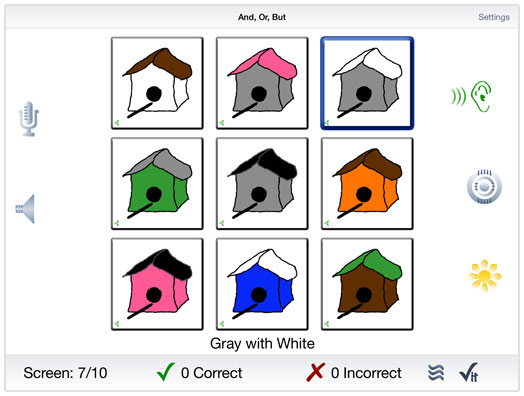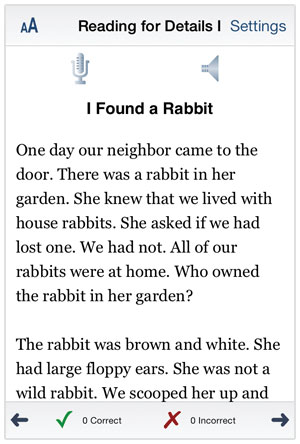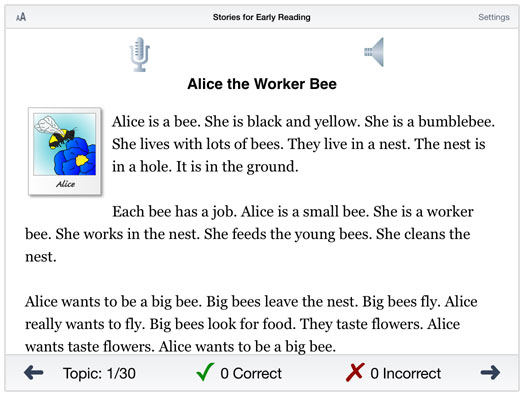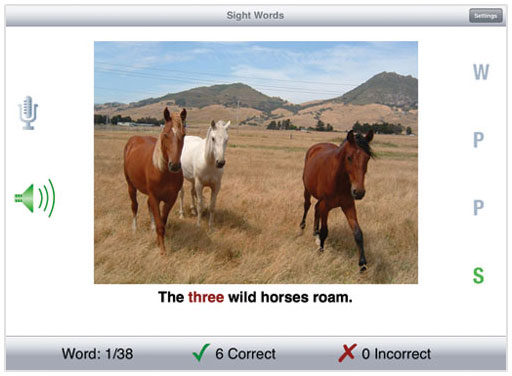App Projects
I worked on more than 29 apps for language, learning, and speech. I am the author of 4 app projects–And, Or, But… Following Simple Directions, Reading For Details I, Reading for Details: Stories for Early Reading, and Learning Sight Words.
I am currently completing work on two literacy projects–Reading for Details: Sight Words and Reading for Details: Confusion Words.
And, Or, But… Following Simple Directions
And, Or, But… requires the player to find the object on the screen that has a specified color, size, number, or spatial relationship.

There are four levels of difficulty and seven tasks: And, With; Qualitative Relationships - Size; Quantitative Relationships - Number; Spatial Relationships; Or; Negatives; and Challenge.
The app can be used with English or Spanish text and sounds.

Target Audience: Traumatic Brain Injury (TBI), Stoke, Down Syndrome, Early Learning Difficulties
Reading for Details I
I wrote the 26 stories about adventures, activities, nature, and human interests. All require careful reading to comprehend and recall details in order to answer the comprehension questions that follow.

The client is asked to determine the main idea of the story, answer some questions that rely on details in the story, and make an inference that is supported by the details. At the end of each story, there is an open-ended question for discussion.
Rationale: The stories require multiple processing skills in attention, memory, inferential thinking, and comprehension.
Reading for Details: Stories for Early Reading
I wrote the 30 short stories on The Early Reading app. Most of the words are 1 or 2 syllables. The simple sentences contain 5 to 8 words. There aren’t contractions, possessives, or quotes. This was an intentional decision.

There are three direct questions that rely on facts in the story. These stories are aimed at very early readers so the questions are straightforward. They do not require making inferences or judgements. In most cases, the correct answer can be found word-for-word in the story.
The fourth question usually requires the reader to recall multiple items from the story. At the end of each story there is an open ended question for discussion.
Target Audience: This app is intended to be used by parents, Speech-Language Pathologists, and Special Education Teachers with children who are having difficulty with reading. It can also be used for remediation of attention and processing deficits due to attention deficit disorder, traumatic brain injury, or stroke.
Learning Sight Words
Studies have shown that good readers look at some words and automatically decode them. The Sight Words app lets beginning readers get a head start on learning these words. It also helps older readers who are struggling with reading to master the sight words. The colorful photos provide a visual cue for the word. The phrases and sentences help the student visualize the word in context.
There are 208 words organized by level of difficulty–Pre-Primer, Primer, Grade 1, Grade 2, and Grade 3.

Target Audience: Designed for neurotypical children ages K-3rd grade. Appropriate for children and adults having difficulty reading due to problems with with Auditory Processing, Auditory Conceptualization, Central Auditory Processing Disorders (CAPD), TBI, or Stroke.
